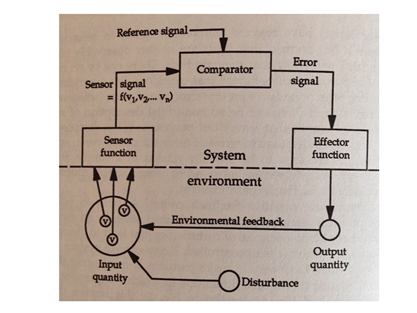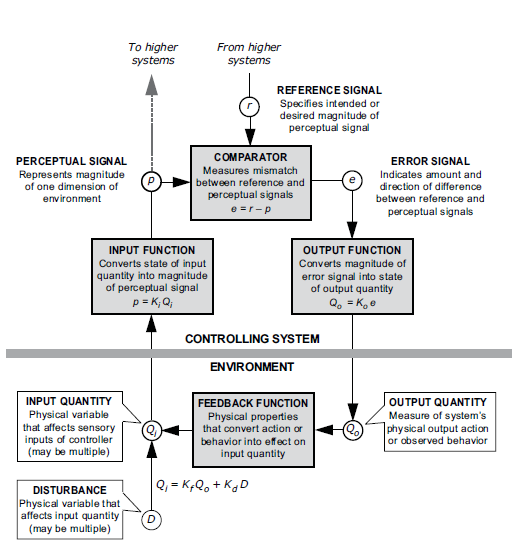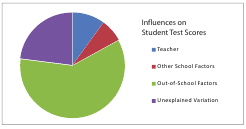
···
Rick,
I think that the main problem we have is your »control of behavior«. Put the citations from Bill’s literature where he is talking about »behavior is control«
or that generaly we control some »aspect« of environment wth output.
Bill P. and others (50 Aniversary) :
HB : Cooperating in this article you agreed that behavior is means of control, so it’s consequence of control not bearer of control. Muscles don’t think,
Make a simple test. Start looking arround and you will see that you are not controlling any »aspect of environment » or »input quantity« with your behavior. Everything
what you are doing is : affecting input (sensors) with your output, chanding actual perception into wanted. With neck muscles (behavior, output) you are affecting input (eyes) to the desired state. You are controlling perception as perception is all there
is.
This is generaly what you are doing in all activities. Even if there is some »aspect of environment« that is affected by your output, is just changing perception
to the desired state. You are just doing what Bill says in his theory. You are not controlling »variables in outer environment« with behavior. You are »controlling your perception« all the time.
Bill P.:
Our only view of the real world is our view of the neural signals that represent it inside our own brains. When we act to make a perception change to our more desireble state … we have no direct knowledgee of what we are doing to the reality that is the origin
of our neural signal; we know only the final result, how the result looks, feels, smells, sounds, tastes, and so forth…<
HB :
I think this is the point of his theory. That’s all what you or we are aware of : perception. You don’t know exactly what you are doing to the environemnt, you
know it when you perceive it. So you can’t control anything in outer environment with »controlling« behavior if you are not aware of what you are doing to the environment in the time of acting. Everything is hidden in perception. All the time you are controlling
perceptions. Some times perception can really reflect what is happening in environment and sometimes not. But that’s all you can relly on. Every interpretaion of perceptions is different. Not two persons see the world outside the same. So there is no fixed,
objective »controlled aspect o environment«, that we could all say that it is the same for eveybody by observing it. It always depends form individual perception and their control. Sometimes you perceive the world as you want to perceive it, and sometimes
more or less as it is. Depends from your perceptions and «control of perceptions«, what you want.
From: Richard Marken (rsmarken@gmail.com via
csgnet Mailing List) [mailto:csgnet@lists.illinois.edu]
Sent: Thursday, August 13, 2015 1:06 AM
To: csgnet@lists.illinois.edu
Subject: Re: Why Control of Perception? (Re: Powers, 2007…)
[From Rick Marken (2015.08.12.1600)]
HB : Why bother Fred if Bill has put it as it should be put :
“behavior is effect of output on input�.
RM: Really? Where does Bill say that?
HB : From the Bill’s diagram (LCS III) or any other. I just wanted to make it clear what is output and how is related to behavior.
Bill P.: This output function too, can be either simple or complex depending on the kind of behavior we’re modeling.
HB : O.K. Maybe you can explain relation about behavior, action and output ? What is behavior in PCT by your oppinion ?
RM : But most of the things we call behavior are both outputs and controlled input quantities
HB : I don’t understand this one, but here it is. One thing is sure. You are equating »output« to »behavior« and something else. Maybe because output (behavior) affects »input quantitty« and so there is behavior
also present in »input quantity«.
How do you explain the title of the book, »Behavior : the control of perception« ?
HB: That’s what “feed-back� is.
RM: Sort of. I like to think of it in terms of the entire “feedback” loop, so the feedback is output “feeding back” on itself via its effect on input and error, the latter being the cause of that same output.
Bill P (LCS III) : … thhe action of the system »feeds-back« to affect it’s own input, the controlled variable. That’s what feed-back means : it’s an effect of
a system’s output on it’s own input. You can’t give a control system a feed-back. It gives itself feed-back.
HB : You can notice that Bill is talking about control system giving itself a feed-back not output itself. Your imagination and interpretations are sometimes
real inventions but it woud be maybe fine if you would stick to Bill’s definition.
It’s good that you put »feeding back« into »inverted commas«, because somebody could think that muscles are »thinking« while »feeding-back« to input. That would
really be «control of behavior« which you are advertising.
HB: That’s all what behavior is doing in the external environment. In Bill’s diagram is this the only thing I can see about behavior. This
is general explanation. There is no “controlled aspect of environment� .
RM: Here is Fig. 1 from Powers 1973 Science paper. Notice that what the output affects is a variable in the environment called the Input quantity. This Input
quantity is a function of physical variables (the v’s) and it represents the aspect of these physical variables (the environment) that corresponds to the controlled perception (called the Sensor signal in the diagram).
HB : Yes the emphasis is that »output« affets a variable called the input quantity. The emphasis is on affect not control.
Bill P. :
….first ordeer perceptual signal reflects only what happens at the sensory ending : ** the source of the stimulation is completely undefined
and unsensed.**
HB :…so it doesn’tt matter whether you put in front sensors (input function) elephant or any other »input quantity«. It’s the same effect on sensors.
Bil P :
If any infromation exists about the source of the stimulus, it exists only distributed over milions of first-order perceptual signal and is explicit in none of them.
HB : The emphasis is on »if«, there is nothing in enviroment that would clearly »correspond« to produced neural currents. But it could be »mixed« somewhere among
milions of them.
Bill P :
The significance of any first-order perceptual signal is therefore extremely limited and local; this applies even in the eye…. There is no information in any one first-order visual signal
to indivicate the origin of the light the input function aabsorbs : the source can fluorecence inside the eyeball or an exploding star a hundered milion years removed in space and time, with no change of the erceptual signal.
The perceptual signal from a touch receptor does not reflect whether the cause is an electrical current, a touch, or a chemical poisoning, or whether a touch occurs to the left or right
of the exact receptor location.
HB : So no matter which sensor or nerv end is stimulated, the effect of the source is unknown to the control system.
Bill P : All informations contained in first-order perceptual signals is therefore information about what is happening to the associated input functoon and about nothing else.
RM (earlier) : I will just add that, in the LiveBlock demo all we know is q.i; we don’t know how q.i is derived from environmental variables, v.1, v.2…v.n. So the LiveBlock demo, though a great way to demonstrate the behavior of variables a control loop,
cannot be used to demonstrate anything about the relationship between q.i and p.
HB: Maybe this is related to what Bill is explaining in relation ; environment - sensor – perceptual signal.
What I can see here is that there isn’t any »imagined input quantity« that could be present in perceptual signal. So it matters only that input function is affected
and that first order perceptual signal refelcts only what is happening at the sensory endning. So whatever is stimulating sensory organs or nerv ends, are physical variables which can not be defined (it may be any in environemnt).
If everything outside is completely undefined why put »input quantity« in environment as pure »imagined » construction right in front of input function. Is this
suggesting that only »input function« is represented in perceptual signal ??
So physical variables in outer environment probably stimulate input function to produce neural currents no matter if they are »input quantity« or any other physical
variable in environment that is not afected by ouptut and disturbances. They have all equal chances to be transformed.
So it seems that it is not important whether environment or »input quantity« or any other part of environment was affected. It matters only what directly affects
input function as that is all that control system will perceive. All other explanations in external environment are just imagination of individuals.
So if we are turning our heads we are affecting directly perceptual organs, which produce milions of neural currents with no definite origin. We don’t affect
any imagined »input quantity«. We directly affect input function. That’ what output is doing.
There is no control in environment that could be sensed by sensor organs, just some changes on »surface« of perceptual organs. Whatever brains »construct« from
perceptual signals after many interesting operations in nervous system (question how nervous system works), is something that is later »recognized« on higher levels.
Bill P:
…¦… using higher levels of organization we »know« that light can come from distant objects
HB : My oppion is that nervous system is constructing perceptual reality inside nerv-net in his own way, manipulating neural currents in some specific way (which
are described in B:CP, 2005).
RM (earlier) : Since this is a rather verbal group I think it’s better to say that that perceptions (perceptual signals) are constructed , not derived, from lower level perceptual inputs and, ultimately,
sensed effects of physical variables.
HB : Well I must say that these are extra points for you Rick in my higher oppinon about you. It’s rising. I must say Rick (although unwilingly J )
that I perfectly agree with you.
I think Rick that you could maybe compare this »findings« with your »new findings« in post where you are admtting your mistake in discussion with Rupert ? Lately
you had so many progresive findigs that’s it worth of putting them together.
RM : The controlling is done by the operation of the entire loop; there is no control of Output and there is no controlling done by the comparator. The comparator
just compares.
RM earlier : Perhaps not simply enough. Bill’s diagram shows a feedback control loop organized around the control of an Input quantity.
RM : Because most things we call “behavior” are both outputs and controlled Input quantities, we say “behavior is control”.
HB : I’m not sure that I understand what you meant. Could you arrange this statements to have some sense or just I don’t understand them. If the controlling is done by the operation of entire loop, how can we
»control input quantity«. Once there is no control of output, and once we can »control behavior«.
Bill P. :
COMPARATOR (B:CP) : The portion of control system that computes the magnitude and direction of mismatch between perceptual and reference signal.
HB : So comparator is not only comparing it’s also computing the difference between reference and perceptual signal (error signal). And this is control.
HB: Behavior is not control. It’s just effect of muscles on environment,
RM: This is true if by “behavior” all you are referring to is output effects on a controlled Input quantity.
HB : I still can’t grab the term »controlled input quantity«. What is making »Input quantity« controlled ? What is controlling »input quantity« ?
»Input quantity« seems to imply that this is the only thing people or living beings can perceive through »input function« because it’s in front of our »nose«.
But we know that people can perceive in the dark monsters instead of trees, that people can perceive dear persons living with them although they are long time dead, we see colors differently although »input quantity« seems to be the same, people can perceive
text differently…and so on.
So it’s not some objective »input quantitty« (which is the same for anyone) responsable for differently perceived results (like you and me reading the same Bill’s
text differently), but nervous system that is somehow constructing »meaning« from perceptual input. What is the role of »input quantity« in all these cases ? Is really only »input quantity« responsable for what we are perceiving from environment ?
The other problem with »input quantity« as Martin pointed out is, that it is presenting just »controlled perception«. So it’s containing just effects of system’s
output and disturbances. But that is not all what it is transformed from environment into perceptual signal. Any physical variable that can affect sensor will be present in milions of neural currents progressing toward comparator. The »input quantitty« shows
just one part of transformation proces in input function.
RM :
But most of the things we call behavior are both outputs and controlled input quantities. So a behavior like “lifting a book” is both an controlled Input quantity (an end result ) and an output (a means of controlling some other input quantity, like putting
the book back up on the shelf). Because most things we call “behavior” are both outputs and controlled Input quantities, we say “behavior is control”.
HB : Now first you say behavior …… is output (a MEANS of controlling some other input quanttity) and on the end »behavior is control«. How can something that
is not existing in external environment (input quantity) be behavior ??? »Input quantitty« is affected by behavior… if… it can 't be be behavior… think…
Maybe you could describe »lifting book in PCT manner.
»Lifting a book« is a perception when you are acting to make
a perception change to more desireble state (affecting input) …you have no ddirect knowledge of what you are doing to the reality (moving book) that is the origin of your neural signals; you know only the final result, how the perception of the book was changing
to the desired perception.… Any othher analysis in outer environment is imagination which can be interpreted by any individual differently.
I borrowed terminology and the whole meaning from Bill
HB : Thinking that entirely or some “aspect of environment� can be controlled with behavior is not PCT reasoning.
RM: Actually, thinking of living (or artificial) control systems as controlling some aspect of the environment is perfectly good PCT reasoning.
HB : Well I hope it’s clear that generaly we can’t speak of »controlled« aspect of environment as there are behviors that do not affect any »aspect of environment« (turning you head, scratching, sitting in the
park and observing, walking, etc.) but affect directly input (sensory organs, nerv ends).
If PCT is theory that can explain all behaviors, then we have to talk only about »output affecting input (sensory organs or nerv ends) as this is in accordance with Bills’ writings B:CP about 1.level sensor function,
and physiological facts).
In this context we can explain all behaviors also those which are affecting some «aspect of environment« in order to affect perception.
But whatever is happening outside (whether something is affected or not) is of secondary importance. First control system has to be »closed« to keep homeostasis, and in some cases »affect environment« to help
achieve and maintain preselected state in controlling system, what is of primary importance and is running cntinuously. Behavior (output) is not continuous.
If organism is not producing internal control enough to survive, no behavior or any effect in environment will not help to survive. Many times organism must help itself. Many times doctors just wait what will
happen in organism whether internal control systems will »win« or «lose« battle for life. I’m talking here about »general theory of control of perception« what I make equal to understanding how organisms function, not whether or not we control all the time
»variables« in external environment. PCT is the theory about how organisms function not how we »control aspect of environment« ??
RM : When you control the shape of the rectangle in the “Control of Perception” demo (http://www.mindreadings.com/ControlDemo/ControlOfPerception.html ),
for example, you are controlling the shape rather than the orientation or size aspect of the environment; when a thermostat controls air temperature it is controlling the temperature rather than the humidity or water vapor aspect of environment.
HB : Living and artificial control systems have some principles in common, but sure they are not working the same. Maybe when analyzing artificial control system
you could talk generaly about »controlled aspect of environment«, but not when humans are in question. I think you went to far.
O.K. Rick I was really surprised last time with your correction of PCT thinking, and I was pleasently surprised with your »construcitivist« thinking.
Maybe we’ll reach the point of understanding PCT. But for that I think you will have to leave »selfregulation« thinking and »control of behavior« and contribute
to more understanding of »control of perception« and how organisms really work.
Best, Boris
Best
Rick
–
Richard S. Marken
Author of Doing
Research on Purpose.
Now available from Amazon or Barnes & Noble

